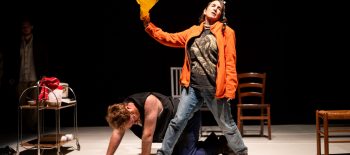On July 30 took place the movie premiere “What was hidden in the Bytom Hamburger Hof?, a production connected to the project “Cultural Emergency”.
It is the third edition of the “Cultural Emergency” project, this time touching on the history of the Jewish community in Bytom.
CULTURAL EMERGENCY is a program aimed at providing access to culture for people suffering from cancer and neurological treatment who,
due to low immunity and long hospital sessions, cannot participate in cultural life on a daily basis.
It is carried out by the Upper Silesian Museum in Bytom in partnership with the University Clinical Center in Katowice and the Silesian Music Society.
“What was hidden in the Bytom Hamburger Hof?” – about the film:
For most of its existence, Bytom was a multicultural city. The cultural mix created by the inhabitants of this area was a source of wealth and openness of the local population,
which included Poles, Germans, Czechs, Roma, and Jews.
Some Jews donated souvenirs to the Upper Silesian Museum, which are the only material remnants of a community that used to be an important part of the city,
but now, almost non-existent and falling into oblivion.
Next to the synagogue, there was the “Hamburger Hof” hotel, where Jews traditionally celebrated family celebrations.
This impressive building from the turn of the 19th and 20th centuries, currently at 6 Plac Grunwaldzki / ul. Podgórna 5, has survived to this day,
although in a much poorer decorative form.
In the Synagogue, that equipment we wish to present, there was, among other things a large collection of books – a valuable heritage of Jewish communities scattered
throughout the territory of the Second Polish Republic. Thanks to these books and souvenirs, we can not only tell about the culture and tradition that once appeared in Bytom
but also recreate its history not only there “
In 2017, a donation was made thanks to which the collections of the Upper Silesian Museum are enriched with unusual items from the former house of prayer of Bytom Jews.
This unique gift includes, inter alia, a collection of 402 volumes of books and their fragments, which were previously kept in the prayer house.
The oldest of them are volumes from the 17th century.
According to the historian and researcher of the history of Jews in Upper Silesia, the Bytom collection, after carrying out the necessary conservation works
(spread over the next few years), will be the third-largest collection of Hebrew religious books in Poland.
The museum would like to use the received equipment (including the original cantor’s pulpit or the altar cabinet, i.e. the Aron Kodesh)
to fully reflect the nature of the prayer house at the exhibition devoted to religious and ethnic communities living in Upper Silesia in the 19th and 20th centuries.
It will be the first such complete and original reconstruction of prayer space in museum interiors in Upper Silesia, presenting the history of the Jewish community in Bytom before 1945.
It will also allow us to present the recent history of Jews migrating to Upper Silesia after 1945.
For the film about the project (in Polish)



